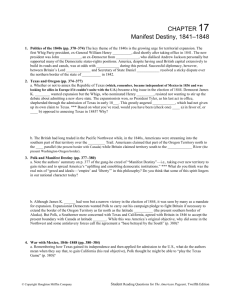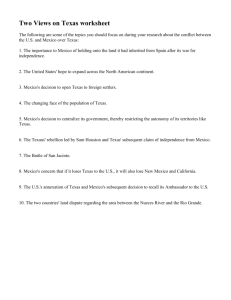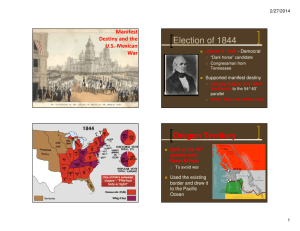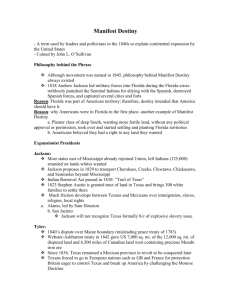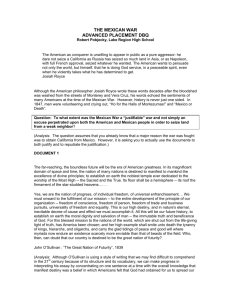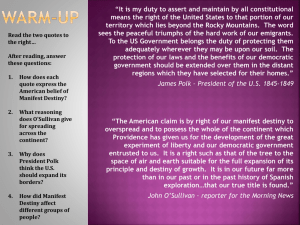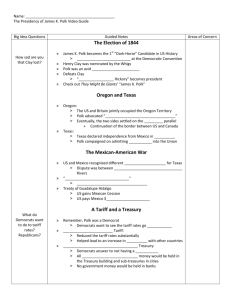American Expansion Tension Arises as the Economy, Democracy
advertisement
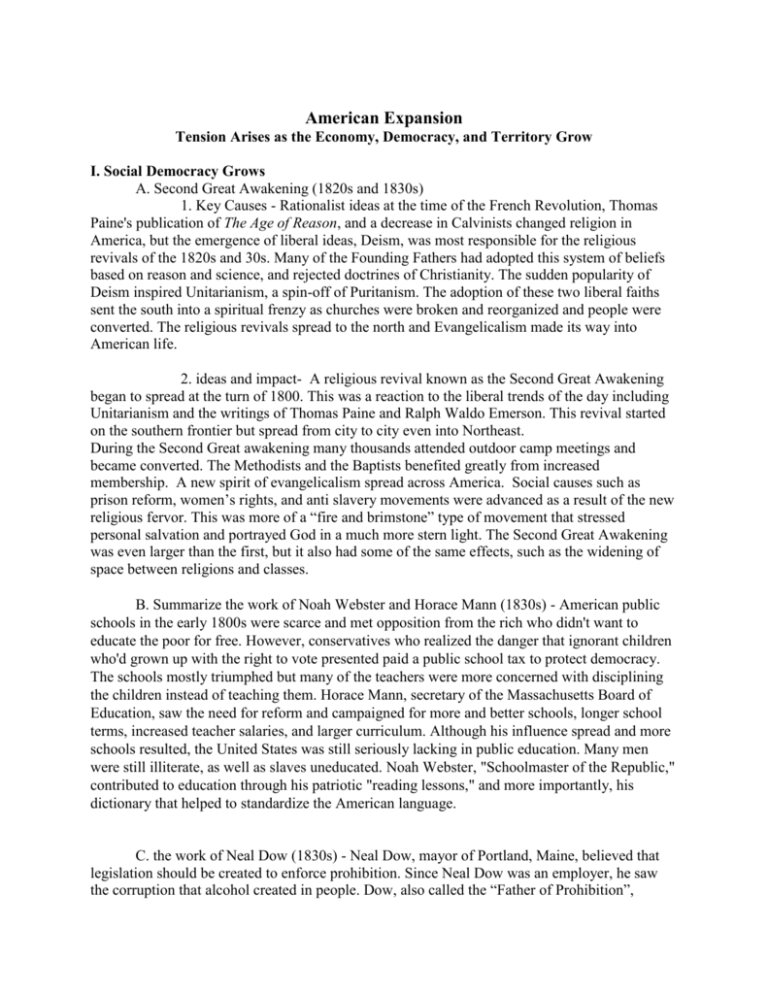
American Expansion Tension Arises as the Economy, Democracy, and Territory Grow I. Social Democracy Grows A. Second Great Awakening (1820s and 1830s) 1. Key Causes - Rationalist ideas at the time of the French Revolution, Thomas Paine's publication of The Age of Reason, and a decrease in Calvinists changed religion in America, but the emergence of liberal ideas, Deism, was most responsible for the religious revivals of the 1820s and 30s. Many of the Founding Fathers had adopted this system of beliefs based on reason and science, and rejected doctrines of Christianity. The sudden popularity of Deism inspired Unitarianism, a spin-off of Puritanism. The adoption of these two liberal faiths sent the south into a spiritual frenzy as churches were broken and reorganized and people were converted. The religious revivals spread to the north and Evangelicalism made its way into American life. 2. ideas and impact- A religious revival known as the Second Great Awakening began to spread at the turn of 1800. This was a reaction to the liberal trends of the day including Unitarianism and the writings of Thomas Paine and Ralph Waldo Emerson. This revival started on the southern frontier but spread from city to city even into Northeast. During the Second Great awakening many thousands attended outdoor camp meetings and became converted. The Methodists and the Baptists benefited greatly from increased membership. A new spirit of evangelicalism spread across America. Social causes such as prison reform, women’s rights, and anti slavery movements were advanced as a result of the new religious fervor. This was more of a “fire and brimstone” type of movement that stressed personal salvation and portrayed God in a much more stern light. The Second Great Awakening was even larger than the first, but it also had some of the same effects, such as the widening of space between religions and classes. B. Summarize the work of Noah Webster and Horace Mann (1830s) - American public schools in the early 1800s were scarce and met opposition from the rich who didn't want to educate the poor for free. However, conservatives who realized the danger that ignorant children who'd grown up with the right to vote presented paid a public school tax to protect democracy. The schools mostly triumphed but many of the teachers were more concerned with disciplining the children instead of teaching them. Horace Mann, secretary of the Massachusetts Board of Education, saw the need for reform and campaigned for more and better schools, longer school terms, increased teacher salaries, and larger curriculum. Although his influence spread and more schools resulted, the United States was still seriously lacking in public education. Many men were still illiterate, as well as slaves uneducated. Noah Webster, "Schoolmaster of the Republic," contributed to education through his patriotic "reading lessons," and more importantly, his dictionary that helped to standardize the American language. C. the work of Neal Dow (1830s) - Neal Dow, mayor of Portland, Maine, believed that legislation should be created to enforce prohibition. Since Neal Dow was an employer, he saw the corruption that alcohol created in people. Dow, also called the “Father of Prohibition”, backed the Maine Law of 1851 which stopped production and sale of alcohol in Maine. Several states began to follow in his footsteps and passed their own prohibition laws. However, it was obvious that legislation would not be able to rid the states of alcohol, and many of those laws soon were revoked or declared unconstitutional. D. education efforts of Mt. Holyoke (1837) and Oberlin College (1838) - Women's higher education was looked down upon in the early 1800s, but that didn't stop many women from trying. Beginning with Emma Willard in the 1820s, women's schools began to gain some respect. Oberlin College shocked traditionalists by first admitting blacks, and then becoming coeducational in 1837, when it opened its doors to women. In the same year, Mt. Holyoke Seminary, a women's school, was established by teacher Mary Lyon. These education efforts were scoffed at by Mossback critics, but the literacy of women helped magazines to flourish. E. Brook Farm and other Utopian experiments (1830s and 1840s) – During this age, several commune style communities were started by reformers that hoped to create a utopia. In Massachusetts, in 1841, intellectuals set up the Brook Farm Experiment which was dedicated to transcendentalist beliefs. Fairly short-lived, in 1846, Brook Farm suffered from a fire and then fully failed due to debt. Other experiments include the Oneida Community, which was more radical and practiced free love, and the Shakers, which were religious communities. While several of these community experiments were attempted, most of them were small and shortlived since they could not compete with free land and endeavor. F. rise and plight of the Church of Latter Day Saints (Mormons) (1820s-1840s) - Plates found by Joseph Smith, a visionary, were translated into what came to be known as the Book of Mormon, and thus, the Church of Jesus Christ off Latter Day Saints was launched. The united Mormons quickly ran into opposition from non-Mormon Ohio, Missouri, and Illinois. Their united front shocked and antagonized individualistic Americans. The intense opposition led to the murder of Mormon leader Joseph Smith and his brother, almost collapsing the entire Mormon faith. However, they were saved by the young and aggressive Brigham Young, who, in search of an escape from persecution, moved them to Utah. After the initial pioneer hardships, the Mormons flourished on the Utah plains thanks to their irrigation methods. Soon, thousands of settlers were arriving as well as European immigrants. Brigham Young turned the community into a prosperous theocracy. A problem arose when the U.S. government was unable to control Young's hierarchy; however, it was resolved without bloodshed. Utah became a state in 1896, after being delayed by the anti-polygamy laws. G. Seneca Falls Conference (1848) – IN 1848, feminists fighting for women’s rights met in New York at the Seneca Falls Conference. During this conference, the “Declaration of Sentiments” was read, which stated that all men and women are created equal. The feminists at the conference demanded that women get the right to vote along with other resolutions. Despite receiving much disrespect and criticism, the Seneca Falls Conference became the starting point for the women’s rights movement. II. Economic Expansion A. Robert Fulton and the impact of the steamboat (1807) - Robert Fulton, a painter- engineer, debuted his steamboat invention on the waters of the Hudson River. The steamboat changed the American waterways and the economy. Waterborne commerce was dangerous, but the power and swiftness of the steamboats eliminated the trouble river travelers might have had. In addition, waterways were converted into two-way streams so what they could carry more of the fast-moving steamboats. Most importantly, steamboats were able to travel against the downstream current, meaning they could go up the Mississippi River. Along with opening up the South, the steamboats opened up the West, and populations sprung up along the banks of rivers. Farmers began to take up more soil because they could ship out, as well as ship in, more cost effectively. B. Erie Canal opens (1825) - The Erie Canal, which ties the Great Lakes to the Hudson River, was completed in 1825, and with its completion brought a great boost to the economy. Cities along the Erie Canal boomed in land value as well as industry. New Cities were created like Syracuse and Rochester, and other small towns such as Cleveland, Detroit, and Chicago, emerged as powerful cities. Farming in the Northwest became profitable and many immigrants flocked to the land. The price and amount of time it took to transport goods dropped drastically and many New England farmers gave up their land or used the canal to travel west. The industrialization of American greatly increased due to the Erie Canal. C. Summarize the impact of the McCormick reaper (1834) and the Deere plow (1837) on agriculture - The Deere plow was a light steel plow, as opposed to the typical wooden plows of the time, that was finally able to break the hard, thick virgin soil of the West, and could be pulled by horses instead of oxen. As the frustration of the farmers eased, the McCormick reaper, a mechanical mower-reaper, was invented to do the work of one man a lot more effectively. Farmers took on more land since they had the power to tend it in a shorter time. However, the bigger responsibility of the farmers caused a large buildup of debt because they kept buying equipment and land. They also looked to expand their factory towns, but they were still landlocked and had no land transportation. The invention of the reaper led to a transportation revolution. D. Samuel Morse invents telegraph (1844) - Samuel Morse invented the telegraph in 1844, with the help of $30,000 from Congress. The telegraph allowed people to communicate over long distances. Not only did the invention make Morse famous and wealthy, but it helped to secure and strengthen a business world that was growing increasingly intricate. E. Elias Howe invents the sewing machine (1846) - The invention of the sewing machine increased northern industrialization as it was the basis of the ready-made clothing industry. However, it caused women to be driven from their houses to work in the factories because someone needed to tend the machines. This job turned them into robots. III. Post-Jackson Politics A. Election of 1836 – During the election of 1836, the still fairly new and unorganized Whig party could not decide on one presidential candidate. Instead they strategized that if a number of “favorite sons” ran they would stop one candidate from winning and the House of Representatives would have to choose the president. The Whigs thought that if it was the House’s decision, they might actually have a chance to win the election. However, Jackson, who was too old to run for a third term, wanted Martin Van Buren to be the next president. Jackson fixed the nomination and pushed Van Buren at the delegates. Jackson supporters also supported Van Buren but not wholeheartedly. Despite the Whig party’s attempt to scatter the vote, Van Buren slipped into office with a good margin in the Electoral College, allowing Jackson to step down. B. Election of 1840 - Martin Van Buren was unenthusiastically nominated again by the Democrats and ran against Whig party nominee William Henry Harrison. The Whigs knew that Harrison would win votes; he had a big reputation for someone who didn't have many noteworthy accomplishments. Their campaign was foolish and set a bad precedent because Harrison didn't have a platform or issues, nor did he have enemies and his vice president was an afterthought. The Whigs were more dependent on the economic distress of Van Buren's term and his unpopularity within his party. However, when Harrison was portrayed as a simple and poor farmer, the Whigs used this to gain him more popularity and denounce Van Buren for being an aristocrat, while, in truth, their class statuses were actually the other way around. Although it seemed that the talented Whig campaigners made Harrison a shoo-in for president, the popular vote was quite close. What made the difference was the wide margin by which Harrison won the electoral vote. Although his election was seen as a protest against hard times, the Democrats were shocked that their solid party and principles had been beaten by a silly campaign. C. the troubles of John Tyler (1841-45) – After President Harrison died, John Tyler became president and is known as the accidental president. Tyler was considered a president without a party because he chose the Whig party based mainly on his dislike of Jackson; however, Tyler disagreed with the Whigs on almost every issue such as the Whig’s pro-bank, pro- protective tariff, and pro-internal improvement views. Tyler’s beliefs lined up more with the Democratic Party. During his presidency, Tyler angered the Whigs by vetoing several of their bills, most notably Clay’s bank bill. D. battles over the Independent Treasury (1840-46) - Van Buren's remedy for the financial ills of the United States was to separate the economy from the government, a Jacksonian principle, thus setting up an independent treasury. This would protect government funds by locking them in private banks. Whigs, interested in using the government to fix the financial problems, opposed Van Buren's divorce plan. They wanted to expand the bank's credit, not shrink it like the independent treasury would do. The independent treasury would also crush Whig hopes of reopening the Bank of the United States. Democrats mildly supported it, but they were really interested in "pet banks." The independent treasury was passed in 1840, however, when Harrison, a Whig, was elected president the next year, the Whigs repealed it. Then, in 1846, the independent treasury was revived by newly elected Democratic president Polk. It stayed in action until it later merged with the Federal Reserve System. E. Walker Tariff (1846) - The Walker Tariff of 1846 was passed under President James Polk. One of Polk’s goals was to lower tariff and his secretary of treasury, Robert Walker, came up with a tariff bill that lowered the rates of the previous tariff by 7%. Southerners greatly supported the bill, while Northerners, especially in New England, did not support the bill and claimed that it would hurt manufacturing. However, due to factors like considerable imports, the Walker Tariff of 1846 ended up being extremely profitable. IV. Expansion A. Causes for Texas War of Independence (1836) - America wanted to colonize Texas, but they had already given it up to Spain in exchange for Florida in 1819. The Spanish were planning to populate this area, but Mexico won their independence first and a regime in Mexico City made arrangements to give Stephen Austin land in Texas to bring American settlers there with the understanding of Mexicanizing them. However, the American settlers refused to be converted and resisted the force of Mexico's government. Friction between the Mexicans and Texan-Americans on issues like slavery, immigration, and local rights resulted. When, Mexico freed their slaves and closed immigration into Texas, the Americans didn't listen, and continued to bring settlers and slaves into Texas. Austin went to Mexico to try to negotiate a solution to their problems with Governor Santa Anna, but he was jailed. Two years later, the clash between Mexicans and Texans reached its breaking point when Santa Anna took away Texans' local rights and put up an army to suppress their resistance. When Texas declared its independence, war broke out. B. Briefly summarize major events and outcome of the Texas War (1836) - In 1836, with Sam Houston as their commander in chief, Texas declared independence from Mexico. In response, Mexican dictator Santa Anna, led an army of men into Texas and trapped several Texans at the Alamo. At the Alamo, almost two hundred Texans were killed, including Jim Bowie and Davey Crockett. Shortly after, at Goliad, American volunteers were defeated, this stirred up American opposition. As Houston’s army continued to retreat, American’s began to come to the aid of Texas. After attracting the Mexicans to San Jacinto, on April 23rd, during the Mexican’s siesta hour, the outnumbered Texans destroyed their opposition and captured Santa Anna. Santa Anna was forced to sign two treaties which took Mexican troops out of Texas and recognized the Rio Grande River as the southwestern border of Texas. Santa Anna argued that the treaties were illegal. After the Texas War, Mexico was angry at the United States for helping the Texans to win the war. They felt that American’s should have followed their neutrality rules. Now that Texas had gained its independence from Mexico, it wanted to become a part of the United States, however, Jackson did not want to spark the slavery issue, and Northerners did not want another slave state in the Union. Since Texas feared Mexico and Santa Anna, they began to look to England and France for help. C. Aroostook War (1838) and the Webster-Ashburton Treaty (1842) - The Maine boundary was being disputed when the British began to build a road from Halifax to Quebec that ran through that territory. Maine had claimed it in the peace treaty of 1783, but fights between Maine and Canada lumberjacks broke out in the disputed territory, the Aroostook River Valley. The fights escalated and threatened to turn into a shooting war when both sides summoned the local militia. However, London took the first step in negotiating and sent a diplomat to America, Lord Ashburton. He met with Secretary Webster and the two quickly established an amicable relationship, agreeing to compromise on Maine's boundary. In the Webster-Ashburton treaty, America received more than half of the disputed territory while Britain got the rest and were allowed to build their Halifax-Quebec road. The Americans also won what would later come to be known as Minnesota, and its precious iron ore, when the British adjusted the U.S.-Canada border. In addition, the Caroline affair was tied off. D. Election of 1844- The election of 1844 between Whig Henry Clay and Democrat James K. Polk was an expression of Manifest Destiny and the issue of Texas played a large role. Polk is known as the first “dark horse” candidate, however he was well known. Polk served as governor of Tennessee and Speaker of the House, and he supported Texas. Both parties used slogans and started rumors about the opposing candidate in an attempt to win support. Henry Clay attempted to hold the views of both the north and south on the issue of annexing Texas which greatly hurt his campaign. James Polk became the president winning both the popular vote and the Electoral College. Many Democrats saw this election as consent to take Texas. E. define the term "manifest destiny" (1845) - Many American citizens felt that it was their mission from God to spread democracy throughout North, and possibly South, America. In doing this they combined the ideas of liberty and empire. Manifest Destiny played a large role in electing James Polk in 1844. He was a Democrat and the idea helped to sway expansionist Democrats away from Clay, the Whig nominee. It was part of the basis of the Democratic platform, as they campaigned for the reannexation of Texas and the reoccupation of Oregon. F. Joint annexation of Texas (1845) – Texas became a major issue in the campaign of 1844 due partially to the fear of British conspirators. When Polk, a democrat won the election, the current president, John Tyler, took the win as permission to annex Texas. Tyler knew that the Whigs, who believed Texas would simply promote more slavery in the US, would not allow him to get a 2/3rds majority vote in the Senate. So, instead, Tyler used a joint resolution which only requires a simple majority in both the House and Congress. The joint resolution passed in 1845 and Texas became the 28th state. The annexation of Texas caused heighten tensions between the US and Mexico because Mexico believed that America stole Texas from them. G. Oregon Treaty (1846) - Polk promised to regain Oregon for the northern Democrats in his campaign in 1844. He didn't want to carry this out because, as a southern Democrat, he was already happy with reannexing Texas. However, he felt bound to do it so he proposed getting a compromised portion of Oregon from England. The British prime minister denied his proposition, but then changed his mind soon after when he realized that the Columbia River was not as great as he had thought. Scared that America would fight for Oregon, the British proposed the same compromise line as Polk. Upon receiving this proposition, Polk was angered that the British had refused him before and left the decision up to the Senate. Although the Treaty of Oregon was quickly approved by the Senate, many northerners were unsatisfied and felt betrayed by the south, who had won the whole state they wanted. This only happened because Mexico was weak and Great Britain was strong. V. The Mexican War (1846-1848) A. economic value of Mexico’s western territory- Mexico controlled some of the land that was richest in natural resources in America. Expansionist Americans were hungry for these lands. America’s size would increase considerably with the acquisition of Mexico’s possessions including Texas and California. Fertile valleys, farmland and vast resources plus the ports on the Pacific Ocean kept Polk’s attention westward. Polk was willing to pay Mexico 25 million for California and Mexico was insulted by the offer. B. boundary disputes with Mexico - The United States had reannexed Texas, but Mexico still thought of the territory as their own. When it was occupied by the Spanish and Mexican, its southwest boundary had been the Nueces River, but the expansionist began to claim the more southern Rio Grande River as Texas' boundary. Initially, the Mexicans were not concerned with the border, but the United States kept out of the area between the two rivers as a precaution. When Mexico refused to listen to Polk's proposition to buy California from them, Polk became angry and decided to provoke war with Mexico. He sent troops into the area between the two rivers and waited for the Mexicans to attack, which they eventually did, resulting in war. C. Slidell Mission- In 1845, President Polk sent John Slidell to Mexico City to negotiate a deal to buy California from Mexico. Slidell was instructed to offer a maximum of $25 million for California and other land to the east; however, the Mexican people were insulted and would not even listen to Slidell’s proposal. Angered by this rejection Polk asked Congress to declare war, however Congress decided that it would be better to wait until Mexico made the first move. D. detail two major military events (1846-48) - One major military event occurred in Buena Vista, Mexico. With his troops, General Zachary Taylor crossed the Rio and entered Buena Vista, where they were attacked by a significantly larger army under Mexico's Santa Anna. Although Taylor's troops were tired, they beat the Mexicans and Taylor became the "Hero of Buena Vista." A second major military event occurred in the heart of Mexico. Troops under the command of General Winfield Scott pushed inward from Vera Cruz until they reached Mexico City. Although they were at a disadvantage in a number of ways, less troops, large enemy, disease, rugged terrain, political opposition from home, Scott and his troops still battled successfully and were able to conquer this vital city in one of the most brilliant American military campaigns. The victory brought General Scott the highest praise. E. Bear Flag Republic in California (1846) – On June 14th, 1846 a small group of Americans revolted against Mexican rule in California. The uprising called the “Bear Flag Revolt” lasted less than a month and California briefly became the “Bear Flag Republic”. This revolt was encouraged by rumors from the US Army that Mexico was about to cause trouble for settlers. Current day California modeled their present day flag with the bear and star from the Bear Flag Revolt. This rebellion disbanded and quickly joined forces with the US when it was learned that war had already been declared against Mexico. F. Treaty of Guadalupe-Hidalgo (1848) - Polk, wanting to end the war as soon as he accomplished his territorial goals, sent Nicholas Trist along with General Scott and his army to negotiate an armistice with Santa Anna. They bribed him into the armistice, which disgusted Polk enough to recall Trist. However, Trist refused to go back and signed the Treaty of Guadalupe-Hidalgo in a last attempt at negotiation. In it, America got Texas and more land up to Oregon and including California, in total about one-half of Mexico. They agreed to pay significantly less than they were willing to pay in Slidell's proposition, even including the price of citizen claims against Mexico. After sending the Treaty to Polk, Polk sent it to the Senate for approval. Although opposition to the war was beginning to emerge in Congress, the terms of the Treaty were good for the amount of time in which it was prepared and ultimately, it was sent in time to pass successfully.



